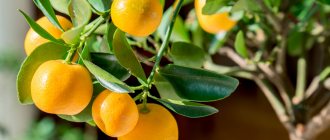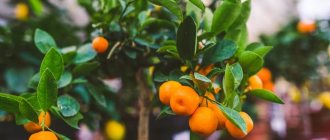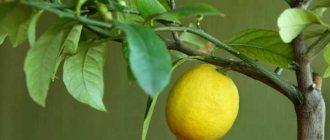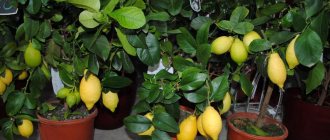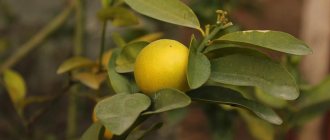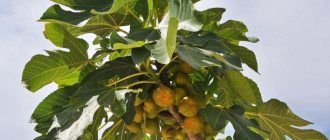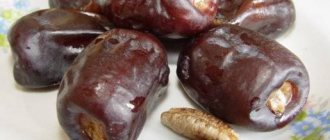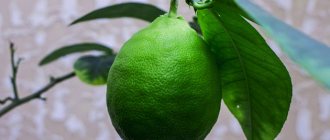The calamondin tree was the result of crossing a kumquat, also called fortunella, with an ordinary tangerine. The resulting exotic fruit belongs to the Rutaceae genus.
Author of the article
Maxim Sverchkov
Professional biologist and breeder with extensive experience and experience.
The plant is common in the countries of southeast Asia. Citrus calamondin is simply called home tangerine. This plant is grown at home. Let's consider the basic conditions and methods of growing this crop.
Description and characteristics of the plant
Calamondin citrofortunella microcarpa is a hybrid crop developed by crossing a tangerine and a kumquat (fortunella).
Citrus belongs to the rue family. At home, in Southeast Asia, the tree can reach seven meters in height.
At home, the height of an adult plant does not exceed 120 cm. The oval-shaped leaves are dark green, dense, and glossy.
White star-shaped flowers exude a delicate aroma. Mass flowering occurs in the spring and summer months; single buds appear even in winter.
Citrofortunella differs from its relatives in that it does not have thorns on its shoots.
Under favorable conditions, calamondin bears fruit all year round.
Fruits weighing 10-20g are similar to small tangerines. The fruits are edible, but not everyone likes the bitter-sour taste and the abundance of small grains.
Hybrid characteristics
In indoor conditions, calamondin is grown in well-lit places. It can be grafted onto a trunk or formed into a bonsai. The tree is used mainly for landscape design and is planted in parks and gardens. The crop is generally not used for harvesting fruits on an industrial scale, except in China, the Philippines, Indonesia and Malaysia. The average yield per tree depends on age and reaches 50 kg by the age of 50 years. Citrus Calamondin can bloom and bear fruit all year round; usually the fruits ripen by the New Year.
The plant grows naturally in the vast expanses of China. There, the golden orange is used to extract juice. And also in Asian countries, tangerine and its species replace the New Year tree for residents and are a mandatory attribute of the holiday.
In natural conditions, citrus reaches 5-7 meters and has a straight trunk. Side branches begin to form close to the base, so they must be pruned to create a standard shape. The morphology of the tree is as follows:
The leaves are oval up to 7 cm long, bent along the central vein. They have a glossy dark green surface and a yellow reverse side. They are placed on the branches alternately on small petioles.- The root system is taprooted and well developed.
- Flowers are white, up to 2.5 in diameter. Inflorescences consist of 5 petals and are located in the axils of the leaves. They have the ability to self-pollinate and attract bees thanks to their pleasant smell.
- The fruits are orange, with a reddish tint. They grow up to 4.5 cm in size and have a flattened shape. The peel is thin, with a pronounced citrus aroma, sweet. The fruit consists of 6-8 sour segments; some varieties may have no seeds. From the mandarin the citrus received its shape and smell, and from the kumquat it got its frost resistance and sweet shell.
When grown at home, calamondin rarely reaches a height of more than 1.5 m. Its lifespan also depends on growing conditions. In a pot it lasts approximately 4 years, and when planted in open ground it reaches more than 20 years.
Popular varieties
Calamondino does not differ in varietal diversity. Breeders have developed several varieties with bright foliage or fruits of various shapes. Only one species is grown indoors - Mitis. In addition to the classic citrus tree, the following are suitable for indoor maintenance:
- Variegated - the leaf blade is framed by an uneven whitish stripe along the edge, and the fruits before ripening resemble the color of a watermelon.
- Tiger - the leaves have a golden border or stripes.
- Shikinari - has tasty large fruits.
- Peters - the tree has beautiful flowers, its decorative qualities are valued, since the fruits are very sour.
Despite the fact that citrofortunella grows quickly and forms a dense crown even in unsuitable conditions, it still needs minimal care.
It is desirable for Calamondin to create a microclimate similar to natural living conditions. Then the tree will begin to bear fruit in 2–3 years, and its height may not exceed 20–25 cm.
Calamondin after purchase
Plants from the store will require special attention, since they are grown using special technology. In addition, conditions change, and the indoor mandarin must adapt to them.
Adaptation
When purchasing a new plant, you need to create a microclimate for it at home that is similar to the previous one. It is also advisable to orient it in relation to the light source, protect it from drafts and maintain the frequency of watering.
Changes in temperature, light and air humidity negatively affect the condition of the plant. The leaves lose their shine, turn yellow and fall off. In this case, it is necessary to take urgent measures:
- create greenhouse conditions (put on a transparent plastic bag);
- ventilate the bush twice a day, removing the bag;
- water moderately, but do not allow the soil to dry out;
- with sufficient lighting, avoid direct sunlight;
- in winter, organize additional artificial lighting.
A sign of recovery will be the appearance in 10-15 days of young shoots and leaves.
Transfer
Two weeks after purchase, it is recommended to transplant the citrofortunella. A small store pot should be replaced with a container 3-4 cm larger in diameter. A tree or bush will grow better in clay or wooden containers. If the flowerpot is plastic, the drainage layer should be thicker.
The root system must be carefully examined and rotten roots removed.
After transplantation, calamondin may lose its leaves. To preserve nutrients, it is better to remove the fruits. You can shorten the branches by sprinkling the cuts with activated carbon powder. It is useful to use medicinal solutions for spraying.
Problems of growing calamondin
Growing citrofortunella will be successful if you pay attention to small but significant details.
| Problem | Cause | Elimination |
| The leaves are falling |
|
|
Calamondin species citrofortunella microcarpa
Citrofortunella does not differ in varietal diversity, since the crop was developed through selection.
Decorative properties predominate in variegated (variegated) varieties. Meiva and Margarita have good taste.
The most common varieties:
- Centeniel is a variegated variety. There are milky stains on the leaves. Unripe fruits look like small watermelons. As the fruit ripens, the stripes disappear and the skin turns bright orange.
- Tiger. The leaves are framed by a narrow golden border; The taste of the fruit is sweet and sour.
- Peters. Decorative variety with beautiful fragrant flowers; The fruits are small and very sour.
- Margarita Nagami. Frost-resistant variety. Fruits with lemon sourness ripen by the end of December.
- Maeva. Sweet citrus without bitterness; oval or round shape.
- Doll. The fruits are pear-shaped with sourness, the peel is sweet.
Rules of care
Calamondin, like any citrus plant, gives the room a very exotic look . Caring for it is not very difficult, but it has its own nuances.
Location and light
The most important condition for the formation of fruits in calamondin is good lighting. In the morning and evening, the flower pot can be left in direct sunlight, but during the day it can be moved to a shaded place, or protected from ultraviolet rays, since they are dangerous for causing burns on the leaves of the plant.
Caring for calamondin at home
Indoor tangerine is often grown as an ornamental crop. In this case, you need to immediately begin forming the crown.
To get a citrus harvest, it is important to regularly apply fertilizers and fertilizing during the period of active flowering and fruit set.
Location and lighting
Citrofortunella is best grown on the east or southeast side of the house. A mature plant will tolerate a few hours of direct sunlight, but not the summer heat.
Sunburn will not only damage the leaves, but also weaken the entire plant.
If the window faces south, a light-protective film is glued to the glass. You can take the tree to a balcony or loggia, providing diffused lighting.
In winter, it is good to use additional artificial lighting for fruit-bearing crops, extending daylight hours to 10-12 hours.
Calamondin does not react well to changes in location. For uniform growth of shoots, the pot is turned clockwise daily, but no more than 10-15° per week.
Temperature
The optimal regime for citrus fruits during the growing season is from +18°C to +26°C. The peculiarity is that the temperature in the area of the crown and root system should be approximately the same.
To prevent the roots from overheating, you should choose a light-colored pot or wrap the pot with a sheet of white paper. If the flowerpot is on a heated floor, you should lift it (place it on a grate).
In winter, it is recommended to ensure a temperature regime not exceeding +18°C. A dormant period with a temperature of +10-12°C allows you to increase the yield next year.
A decrease to +2-3°C is dangerous even for frost-resistant varieties.
Watering and air humidity
The soil in the flowerpot should be kept moist at all times. When the top layer dries a centimeter and a half, the soil must be shed until water appears in the pan. It is better to drain the excess so that the roots do not rot. Water for irrigation should be left for at least 24 hours in an open container.
The foliage needs to be sprayed daily with a spray bottle.
In winter, the frequency of watering is reduced, and air humidity must be increased. Special devices, containers with water or a wet towel on the heating radiator will help with this.
Feeding and fertilizers
With the beginning of active growing season, it is necessary to regularly feed the tree 3-4 times a month. At a flower shop you can purchase complex fertilizers for citrus fruits or a composition for flowering plants.
For root feeding, a 0.5% solution of ammonium nitrate with the addition of potassium chloride (2 g per liter) is suitable.
Special foliar fertilizers are also useful, which, after spraying, are absorbed by leaf tissue.
In winter, fruit-bearing calamondin can be fertilized once a month.
Pruning citrofortunella
A spherical bush or slender tree begins to form before the onset of the intensive growth phase. The procedure should be carried out in late February-early March.
In addition to being decorative, this is also a sanitary measure. It is acceptable to remove about 30% of the growth.
Remove dried and damaged branches, as well as those that break symmetry. In summer, long shoots are shortened by pinching.
Obtaining fruits
As a rule, flower shops sell calamondins with fruits already hanging on their branches. When purchasing such a plant, remember that its fruits are most likely not ripe. In addition, you should take into account the fact that when you bring the tree home, its fruits may fall off.
If you purchased a young bush that does not yet bear fruit, then it is quite easy to make it bear fruit. The most important thing is to provide the bush with the most favorable conditions for growth. Do not forget to timely apply fertilizers to the substrate, provide high air humidity and a dormant period, and then this unusual citrus plant will delight you with its fruits.
After the fruits have ripened well, they are carefully trimmed and, if necessary, stored in a place where it is always cool. In order for the plant to bear fruit annually, you need to monitor the condition of its crown. Those stems and branches that have not produced fruit for the second year in a row must be cut off.
Planned replanting of home tangerine
Gardeners advise planting seedlings grown from seeds or cuttings when they grow to 20-25 cm.
Young citrus needs to be replanted annually in early spring. A three-year-old plant is replanted after a year.
A large tree in a spacious tub does not need to be replanted; it is enough to replace the top layer of soil.
Each time it is recommended to increase the diameter of the pot by 5-8 cm.
For a healthy plant, a simple transshipment procedure is carried out. The entire lump of earth from the old dish is transferred to the new one. At the same time, beneficial saprophytic fungi that complement the root system are not damaged.
The soil mixture is prepared from turf soil (2 parts), humus (1 part) and coarse sand (1 part). The drainage layer is poured 3-4 cm thick.
The root collar should not be deeply buried; it is better to fill it with soil at the same level.
Reproduction of Calomondin
The lifespan of a homemade tangerine is short - 5-6 years, but the plant can be propagated and new specimens grown.
Growing citrofortunella from seed
This is the simplest method. However, citrofortunella grown from seeds begins to bear fruit after a few years, and sometimes does not bear fruit at all.
The seeds should be taken from fresh, well-ripened fruit.
Plant the seeds in a loose, fertile soil mixture, deepening them to 1 cm. After abundant watering, set up a greenhouse, covering it with a glass jar.
After a month and a half, sprouts appear. When 4-5 leaves develop on each, they are planted in separate pots.
Cuttings from homemade tangerine
Calamondin can be propagated by cuttings in late spring or early summer. You need to select a healthy branch with 2-3 buds closer to the top of the crown and cut it with a sharp knife.
For better rooting, the shoot should be soaked in a stimulant solution. The most commonly used are “Epin” or “Kornevin”.
Then the cutting is transferred to a pot with prepared soil and a mini-greenhouse is set up.
The place for the greenhouse should be bright. The seedling needs to be ventilated twice a day, removing the jar for 15-20 minutes.
With sufficient humidity and a comfortable temperature (+25°C), the plant will take root; after 3-4 weeks it can be transplanted into a pot.
Propagation by cuttings allows you to get the first harvest in the second year. Citrus retains its varietal qualities and does not require grafting.
Calamondin dormant period
Calamondin is one of those plants that needs properly organized wintering.
The dormant (wintering) period should begin in November and last until February. In order for this period to be successful, it is necessary to provide the calamondin with full daylight hours and a cool temperature - no higher than +12°C. At this time, the number and frequency of watering is also reduced, which after a month should be carried out 1-2 times every 4 weeks. The plant “wakes up” in March, after which its growth and vegetation intensify.
Diseases and pests of calamondin
Plants are more likely to suffer from pests and diseases if they are not properly cared for. A healthy, strong tree is less susceptible to disease.
Anthracnose
A dangerous fungal disease appears in the form of greenish or brown spots on leaves and stems. Dried leaves fall off, depressions form on the branches, disrupting the movement of plant juices.
In dry weather, cracks appear on the stems; at high humidity the shoots rot.
It is necessary to cut off all affected parts (twigs, ovary, fruits), then burn.
To treat anthracnose, use “Fitosporin-m” or a 1% solution of Bordeaux mixture. Prevention consists of timely fertilization with microelements.
Sooty fungus
Often, sooty fungus develops on the sticky secretions of scale insects. Respiration and photosynthesis of the leaf blade are disrupted.
Settling on tangerine leaves, the fungus spoils the appearance of the plant. Black plaque should be washed off with warm (+40-45°C) water. The room must be well ventilated.
Gommoz
Sometimes sticky brown droplets appear from a crack on the trunk, hardening in the air. This specific disease is gum disease (homosis). The cause may be excess nitrogen in the soil.
The wound must be cleaned, disinfected with a solution of potassium permanganate, and covered with garden varnish. It is important to provide favorable conditions: watering with warm water, good drainage, sufficient lighting.
Pests
The main enemies of citrofortunella are scale insects, spider mites, whiteflies and aphids.
To combat parasites, mechanical and chemical methods are used.
Leaves and shoots are wiped on all sides with a napkin soaked in a solution of green or laundry soap. A week later the procedure is repeated.
Soap-oil emulsions are effective (stir a spoonful of machine or burdock oil in a liter of heated soapy water).
Tar soap (10 g per liter of water) helps get rid of aphids.
For extensive lesions, it is recommended to use the drugs “Fitosporin”, “Calypso”, “Fitover”.
